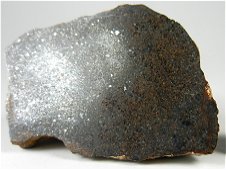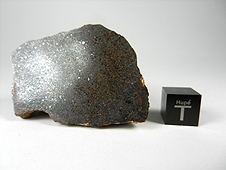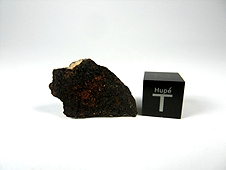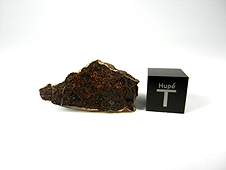NWA 3133 Metachondrite (CV) Meteorite

NWA 3133, a one-of-a-kind Anomalous Primitive Achondrite (Metachondrite) found 2004 in the Sahara desert. Some may ask: OK, another Primitive Achondrite -- What is the big deal? First of all, primitive achondrites are rarer than planetary meteorites and anomalous specimens are among the rarest. Let me tell you the history of this material first and then try to explain its importance.
NWA 3133 was first thought to be a Brachinite or a recrystallized chondrite prompting the two laboratories, Northern Arizona University and the University of Washington, to seek oxygen isotope testing, a way to determine its final classification. A specimen was submitted to the University of Western Ontario for this very purpose. The results were received in June and they plotted so far away from any known achondrite that one scientist had to ask, "How is this possible?" The results were so outrageous and potentially significant that it was decided to send out a second specimen for confirmation. The second specimen was sent blind to the Geophysical Laboratory in Washington D.C. for analysis. The results confirmed the important findings at the University of Western Ontario: NWA 3133 oxygen isotopes plot further away from the Earth-Moon line than any known achondrite including NWA 011.
Link to oxygen Isotope chart:
Click here to see the oxygen isotope chart for NWA 3133
The oxygen isotope data for NWA 3133 plot directly on the mixing line for CV3 chondrites including the most studied meteorite in the world, Allende. A lot is known about CV type chondrites and equally substantial, a lot is not known. Scientists have been deliberating for a long time about carbonaceous chondrites and their parent bodies. This meteorite can serve to answer century-old questions like: Are CV chondrites really a regolith from a broken small planet-sized parent body? Was the original CV parent body differentiated with a metal core surrounded by a silicate-rich mantle and a chondrule-rich regolith? This specimen could give researchers the opportunity to study the inner workings of a failed small planet and has already caused a commotion among world-renowned scientists even before it was formally announced.
Here are a few comments made by scientists in regards to NWA 3133:
"Am I jaded or what? I'm ignoring two new pieces of Mars and getting so worked up over pieces of a probably long-destroyed planetary body that may never be found in space. But I can guarantee the deepest interest in an isotope map of its extreme range of heterogeneity and, maybe a new advance in understanding the inner workings of small planets!"
"This could be a very significant study and combined with your plans for additional isotope work, would probably result in a classic!"
"Thanks for the opportunity to work on these amazing rocks!!!"
"NWA 3133 could be regarded as the first known CV7 Chondrite, and may have been formed by metamorphic recrystallization (or perhaps by igneous processes) in the CV parent body."
The scientific importance of this new meteorite cannot be overstated. More than 60 grams have already been provided as type specimens to two different institutions, at this point tripling the NomCom required amount.
Meteoritical Bulletin entry for NWA 3133:
Click here for the Official classification of NWA 3133
NWA 3133 was first thought to be a Brachinite or a recrystallized chondrite prompting the two laboratories, Northern Arizona University and the University of Washington, to seek oxygen isotope testing, a way to determine its final classification. A specimen was submitted to the University of Western Ontario for this very purpose. The results were received in June and they plotted so far away from any known achondrite that one scientist had to ask, "How is this possible?" The results were so outrageous and potentially significant that it was decided to send out a second specimen for confirmation. The second specimen was sent blind to the Geophysical Laboratory in Washington D.C. for analysis. The results confirmed the important findings at the University of Western Ontario: NWA 3133 oxygen isotopes plot further away from the Earth-Moon line than any known achondrite including NWA 011.
Link to oxygen Isotope chart:
Click here to see the oxygen isotope chart for NWA 3133
The oxygen isotope data for NWA 3133 plot directly on the mixing line for CV3 chondrites including the most studied meteorite in the world, Allende. A lot is known about CV type chondrites and equally substantial, a lot is not known. Scientists have been deliberating for a long time about carbonaceous chondrites and their parent bodies. This meteorite can serve to answer century-old questions like: Are CV chondrites really a regolith from a broken small planet-sized parent body? Was the original CV parent body differentiated with a metal core surrounded by a silicate-rich mantle and a chondrule-rich regolith? This specimen could give researchers the opportunity to study the inner workings of a failed small planet and has already caused a commotion among world-renowned scientists even before it was formally announced.
Here are a few comments made by scientists in regards to NWA 3133:
"Am I jaded or what? I'm ignoring two new pieces of Mars and getting so worked up over pieces of a probably long-destroyed planetary body that may never be found in space. But I can guarantee the deepest interest in an isotope map of its extreme range of heterogeneity and, maybe a new advance in understanding the inner workings of small planets!"
"This could be a very significant study and combined with your plans for additional isotope work, would probably result in a classic!"
"Thanks for the opportunity to work on these amazing rocks!!!"
"NWA 3133 could be regarded as the first known CV7 Chondrite, and may have been formed by metamorphic recrystallization (or perhaps by igneous processes) in the CV parent body."
The scientific importance of this new meteorite cannot be overstated. More than 60 grams have already been provided as type specimens to two different institutions, at this point tripling the NomCom required amount.
Meteoritical Bulletin entry for NWA 3133:
Click here for the Official classification of NWA 3133
Copyright 2012 - Current All Rights Reserved Nature's Vault, Inc.





